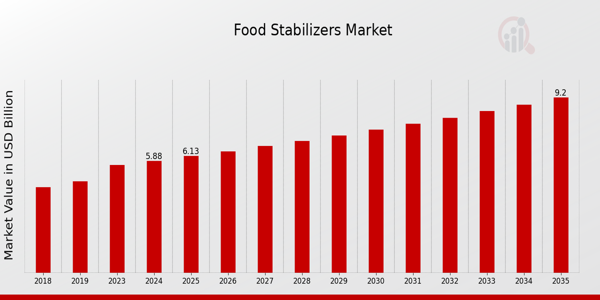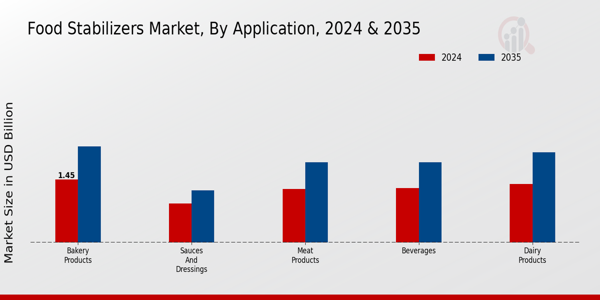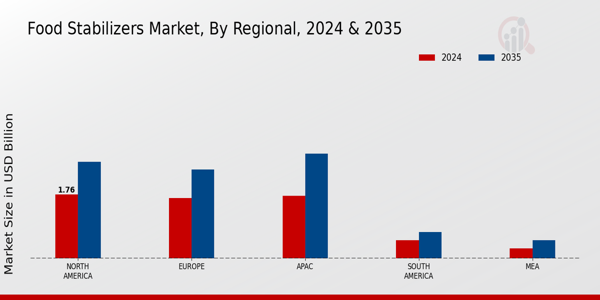Food Stabilizers Market Overview
As per MRFR analysis, the Food Stabilizers Market Size was estimated at 5.65 (USD Billion) in 2023. The Food Stabilizers Market Industry is expected to grow from 5.88(USD Billion) in 2024 to 9.2 (USD Billion) by 2035. The Food Stabilizers Market CAGR (growth rate) is expected to be around 4.15% during the forecast period (2025-2035).
Key Food Stabilizers Market Trends Highlighted
The Global Food Stabilizers Market is witnessing significant trends driven by various factors. One key market driver is the increasing demand for processed and convenience foods, as consumers lead busier lifestyles and seek easy-to-prepare meals. This rise in demand enhances the need for stabilizers to maintain texture, appearance, and shelf life in food products. Additionally, growing consumer awareness of health and nutrition has led to a shift towards clean-label products, prompting manufacturers to seek natural and organic stabilizing agents that appeal to health-conscious consumers. The trend towards plant-based and vegan food products also bolsters the need for innovative stabilizers that can substitute traditional animal-derived ingredients.There are many different openings as food producers look into new applications of stabilizers in dairy products, bakeries, and sauces. An increase in the use of ethnic and international foods causes the need for new, diverse custom stabilizers for different culinary requirements. Supporting regulations regarding food innovation and the ever-increasing focus on food safety regulations internationally form additional favorable conditions for the growth of the market. There is a growing awareness of sustainable food production, which is also shifting the focus to researching new biodegradable and eco-friendly stabilizers.
The global shift towards more sustainable food systems is influencing how stabilizers are produced and marketed. This focus on sustainability not only addresses consumer demands but also aligns with government initiatives aimed at reducing environmental impact in food production. As the market continues to evolve, the integration of advanced technologies in the development of stabilizers presents a potential for further growth, enabling the creation of more effective solutions that meet the changing preferences of consumers globally.

Source: Primary Research, Secondary Research, MRFR Database and Analyst Review
Food Stabilizers Market Drivers
Increasing Demand for Processed Food Products
The Global Food Stabilizers Market Industry is experiencing significant growth driven by the increasing demand for processed food products among consumers. The World Health Organization indicates that globally, about 60% of adult diets now consist of processed foods. This trend is influencing manufacturers to incorporate food stabilizers that improve texture, extend shelf life, and maintain food quality. Furthermore, organizations such as the Food and Agriculture Organization highlight the benefits of food stabilizers in enhancing food preservation and safety in various regions.With the rising population and shifting lifestyles contributing to fast-paced eating habits, the demand for convenient, ready-to-eat food options is set to escalate, further bolstering the Global Food Stabilizers Market.
Growing Awareness of Food Safety Standards
There is a growing awareness regarding food safety standards across the globe, which significantly contributes to the expansion of the Global Food Stabilizers Market Industry. Regulations from agencies like the United States Food and Drug Administration (FDA) and the European Food Safety Authority (EFSA) mandate the use of stabilizers that ensure food safety and quality. As a result, food manufacturers are investing in food stabilizers to comply with these regulations, leading to a projected increase in the market value.For example, the FDA has reported an increase in inspections of food processing facilities, highlighting the importance of adhering to food safety protocols. This trend is expected to create sustained demand for food stabilizers within the industry.
Rising Health Consciousness Among Consumers
There is a notable rise in health consciousness among consumers globally, which is impacting food product formulations and driving the Global Food Stabilizers Market Industry. According to the World Health Organization, approximately 39% of adults globally are classified as overweight or obese, leading to an increased focus on healthier food ingredients. This trend towards healthier eating habits has prompted manufacturers to seek stabilizers that can be used in low-fat and reduced-calorie products without compromising quality.Additionally, organizations such as the International Food Information Council report that healthier food options are increasingly being prioritized by consumers, fueling demand for food stabilizers as they enhance the product's overall appeal while aligning with health trends.
Technological Advancements in Food Processing
Technological advancements in food processing are a key driver in the growth of the Global Food Stabilizers Market Industry. Innovations such as high-pressure processing, nanotechnology, and advanced emulsification techniques are revolutionizing food stabilization methods. Industry leaders, like Nestlé, have been actively investing in Research and Development to enhance food processing technologies, which improves the performance of food stabilizers.The International Journal of Food Science and Technology suggests that innovations in extraction and stabilization techniques will increase the efficacy of stabilizers, thereby ensuring food products meet consumer demands for freshness and longevity. As food technology continues to evolve, the reliance on sophisticated stabilizers is expected to deepen, supporting the market's expansion.
Food Stabilizers Market Segment Insights
Food Stabilizers Market Application Insights
The Application segment of the Global Food Stabilizers Market holds significant importance, contributing to the overall valuation and growth of the industry. In 2024, the overall market was valued at approximately 5.88 USD Billion, with the following applications showcasing robust performance. The Dairy Products segment led with a valuation of 1.35 USD Billion in 2024, projected to increase to 2.08 USD Billion by 2035, underscoring the growing consumer preference for creamy and smooth dairy products that require stabilization for texture and shelf life.This sector naturally dominates due to the high demand for dairy alternatives and innovations in product formulations. The Beverages segment was also noteworthy, valued at 1.25 USD Billion in 2024, anticipated to rise to 1.85 USD Billion by 2035, driven by the increasing consumer focus on health benefits and fortified beverages, thus requiring stabilizers for maintaining consistency and flavor. In the Bakery Products category, the market stood at 1.45 USD Billion in 2024, expected to reach 2.22 USD Billion by 2035, where stabilizers play crucial roles in improving texture and shelf life, making it a vital part of this sector.Meat Products were valued at 1.23 USD Billion in 2024 and are projected to grow to 1.85 USD Billion by 2035, driven by the demand for processed and ready-to-eat meat items, where stabilizers help preserve freshness and quality. Lastly, the Sauces and Dressings segment had a valuation of 0.90 USD Billion in 2024 and will increase to 1.20 USD Billion by 2035, which is significant for providing the desired viscosity and mouthfeel, thus enhancing the overall eating experience. The consistent demand across these various applications illustrates the critical role of food stabilizers in not only improving the quality and appeal of food products but also catering to prevailing market trends that emphasize health, convenience, and longevity.The dynamics of the Global Food Stabilizers Market reveal that as consumer tastes evolve, the importance of innovative stabilizing solutions grows, paving the way for continued market expansion across the Global landscape.

Source: Primary Research, Secondary Research, MRFR Database and Analyst Review
Food Stabilizers Market Type Insights
The Global Food Stabilizers Market has shown significant growth dynamics, with a valuation of 5.88 USD Billion by 2024. This market comprises several key types, which play crucial roles in various applications. Emulsifiers serve to stabilize mixtures that would otherwise separate, contributing to the consistent quality of numerous food products. Thickeners are essential for maintaining texture and improving mouthfeel in sauces and desserts, while gelling agents are vital in formulating products like jellies and gummies, ensuring they achieve the desired consistency.Starches are known for their versatile applications, enhancing texture and acting as a binding agent in processed foods. Texturizers contribute to the mouthfeel and overall sensory experience of food products, making them important in the formulation of dairy and meat substitutes. With a robust compound annual growth rate expected for the coming years, these types are vital in catering to evolving consumer preferences and dietary needs across the globe, driven by rising demand for convenience foods and clean-label products. Key market trends reflect innovations in formulations and a shift towards natural and plant-based stabilizers as businesses aim to enhance product quality and comply with consumer health consciousness.
Food Stabilizers Market Source Insights
The Global Food Stabilizers Market, particularly in the Source segment, is seeing significant attention as it is pivotal to maintaining food quality and extending shelf life. In 2024, the market reached a valuation of 5.88 billion USD, reflecting the growing demand for effective stabilizing agents in food products. The Source segment further encompasses Natural, Synthetic, and Microbial stabilizers, each playing a crucial role in the food industry. Natural stabilizers are becoming increasingly popular due to rising consumer preference for clean-label products and health-conscious formulations.In contrast, Synthetic stabilizers, while effective, face scrutiny regarding health implications, thus driving the need for innovation in this area. Microbial stabilizers are noteworthy for their ability to enhance fermentation processes and improve food texture, making them particularly significant in dairy and bakery products. The global market is buoyed by trends for healthier eating, regulatory support for food safety standards, and heightened consumer awareness about food ingredients. Challenges remain, including regulatory hurdles and sustainability pressures, but the opportunities for advancements in stabilizer technologies and formulations continue to shape the Global Food Stabilizers Market landscape positively.
Food Stabilizers Market Form Insights
The Global Food Stabilizers Market has shown significant growth and development, particularly in the Form segment, which encompasses various forms such as Powder, Liquid, and Granules. In 2024, the market reached a valuation of 5.88 USD Billion, reflecting the increasing demand for food stabilizers due to changing consumer preferences and the growth of the food processing industry. Each form has its unique applications, with Powder and Granules often being favored for their ease of use and longer shelf life, making them essential in applications like baked goods and confectionery.Liquid stabilizers, on the other hand, offer versatility in product formulation, particularly in sauces and dressings, which are experiencing rising consumer demand. The significance of these forms is further enhanced by their crucial role in improving the texture, consistency, and stability of food products. Furthermore, market growth is being driven by advancements in food technology and the increasing focus on clean-label products, presenting robust opportunities for manufacturers. The overall landscape indicates a favorable climate for continued innovations and expansion in the Global Food Stabilizers Market.
Food Stabilizers Market Regional Insights
The Global Food Stabilizers Market is poised for substantial growth across various regions, with overall market values reflecting a significant increase from 2024 to 2035. North America held a major share with a valuation of 1.76 USD Billion in 2024 and is expected to rise to 2.65 USD Billion by 2035, driven by the increasing demand for processed foods and technological advancements in food production. Europe followed closely, valued at 1.66 USD Billion in 2024 and projected to reach 2.44 USD Billion in 2035, as consumers prioritize food safety and quality.The Asia-Pacific region, valued at 1.72 USD Billion in 2024 and a projected 2.88 USD Billion in 2035, is witnessing rapid growth due to urbanization and rising disposable incomes, making it a significant market. South America, albeit smaller, had a valuation of 0.5 USD Billion in 2024, expected to expand to 0.73 USD Billion in 2035, with an emerging focus on food stability in local industries. The Middle East and Africa, having a valuation of 0.28 USD Billion in 2024 and 0.5 USD Billion in 2035, presents growth opportunities but faces challenges like infrastructure and distribution issues.Overall, the Global Food Stabilizers Market segmentation reveals diverse growth patterns and opportunities based on regional demands and trends.

Source: Primary Research, Secondary Research, MRFR Database and Analyst Review
Food Stabilizers Market Key Players and Competitive Insights
The Global Food Stabilizers Market is characterized by constant innovation and adaptation to evolving consumer preferences and regulatory changes. The competitive landscape is shaped by a range of factors, including technological advancements, product differentiation, and strategic partnerships. Companies in this sector are increasingly focused on developing stabilizers that enhance product quality, improve shelf life, and cater to the growing demand for clean-label ingredients.As consumer awareness of health and nutrition continues to rise, market players are responding by expanding their portfolios to include natural and organic stabilizers. The market is marked by a strong presence of established manufacturers as well as emerging players who are vying for market share through competitive pricing and unique value propositions.Kerry Group stands out as a prominent player in the Global Food Stabilizers Market, leveraging its decades of experience in the food industry to provide a diverse range of stabilizing agents. The company's strengths lie in its robust research and development capabilities, which allow it to innovate continuously and respond to market demands effectively. Kerry Group has established itself internationally with a broad footprint, addressing various segments such as dairy, bakery, and meat processing. The company emphasizes sustainability in its production processes, which resonates well with contemporary consumer preferences. Furthermore, Kerry Group's commitment to quality and customer service strengthens its market position, ensuring long-term relationships with clients across different regions.DuPont also holds a significant position in the Global Food Stabilizers Market, recognized for its expertise in food science and technology. The company offers a wide array of stabilizers designed to enhance food texture, stability, and preservation. DuPont's strong R&D focus results in cutting-edge products that meet the diverse needs of the global food industry. The company has a well-established market presence, bolstered by strategic mergers and acquisitions that have expanded its product portfolio and geographic reach. Key products from DuPont include emulsifiers, texturizers, and gelling agents, which cater to various applications in the food industry. The company’s strengths include its leading-edge technologies, strong brand reputation, and commitment to sustainable practices, positioning DuPont as a key competitor in the global food stabilizers marketplace.
Key Companies in the Food Stabilizers Market Include
- Kerry Group
- DuPont
- FMC Corporation
- Naturex
- CP Kelco
- Archer Daniels Midland
- Cargill
- Symrise
- Ingredion
- Tate and Lyle
- Givaudan
- MGP Ingredients
- Ashland
- Kemin Industries
- BASF
Food Stabilizers Market Industry Developments
The Global Food Stabilizers Market has seen notable developments recently, particularly as companies like Kerry Group, DuPont, and Cargill continue to innovate and expand their product offerings to meet changing consumer preferences. The market is projected to experience significant growth due to rising demands for convenience foods and clean-label products, influencing companies to enhance their stabilizer formulations. In recent months, DuPont announced its acquisition of a specialty ingredient company to strengthen its portfolio, a move that reflects the continuous consolidation trend in this sector, while in April 2023, Cargill expanded its operations, aiming for more sustainable solutions in food stabilization. Additionally, the surge in plant-based food consumption has prompted companies such as Ingredion and Givaudan to focus on naturally derived stabilizers. Over the past two years, the market has experienced growth, driven by advancements in food technology that facilitate longer shelf-life and improved texture, with an increasing emphasis on health and wellness trends influencing product development. The Global Food Stabilizers Market is constantly evolving, creating new opportunities and challenges for major players and pushing for further innovation to cater to consumers' demands.
Food Stabilizers Market Segmentation Insights
Food Stabilizers Market Application Outlook
Dairy Products
Beverages
Bakery Products
Meat Products
Sauces and Dressings
Food Stabilizers Market Type Outlook
Emulsifiers
Thickeners
Gelling Agents
Starches
Texturizers
Food Stabilizers Market Source Outlook
Natural
Synthetic
Microbial
Food Stabilizers Market Form Outlook
Powder
Liquid
Granules
Food Stabilizers Market Regional Outlook
North America
Europe
South America
Asia Pacific
Middle East and Africa
| Report Attribute/Metric Source: |
Details |
| MARKET SIZE 2023 |
5.65(USD Billion) |
| MARKET SIZE 2024 |
5.88(USD Billion) |
| MARKET SIZE 2035 |
9.2(USD Billion) |
| COMPOUND ANNUAL GROWTH RATE (CAGR) |
4.15% (2025 - 2035) |
| REPORT COVERAGE |
Revenue Forecast, Competitive Landscape, Growth Factors, and Trends |
| BASE YEAR |
2024 |
| MARKET FORECAST PERIOD |
2025 - 2035 |
| HISTORICAL DATA |
2019 - 2024 |
| MARKET FORECAST UNITS |
USD Billion |
| KEY COMPANIES PROFILED |
Kerry Group, DuPont, FMC Corporation, Naturex, CP Kelco, Archer Daniels Midland, Cargill, Symrise, Ingredion, Tate and Lyle, Givaudan, MGP Ingredients, Ashland, Kemin Industries, BASF |
| SEGMENTS COVERED |
Application, Type, Source, Form, Regional |
| KEY MARKET OPPORTUNITIES |
Increasing demand for clean-label products, Rising plant-based food innovations, Expansion in emerging markets, Growing consumer health awareness, Technological advancements in stabilizer formulations |
| KEY MARKET DYNAMICS |
Rising demand for processed foods, Health consciousness among consumers, Regulatory compliance and safety standards, Innovations in food technology, Increasing food industry applications |
| COUNTRIES COVERED |
North America, Europe, APAC, South America, MEA |
Food Stabilizers Market Highlights:
Frequently Asked Questions (FAQ) :
The Global Food Stabilizers Market is expected to be valued at 5.88 USD Billion in 2024.
The market is projected to reach 9.2 USD Billion by the year 2035.
The market is expected to grow at a CAGR of 4.15% during the forecast period from 2025 to 2035.
The Dairy Products segment is valued at 1.35 USD Billion in the year 2024.
The Beverages segment is expected to reach a value of 1.85 USD Billion by 2035.
The Bakery Products segment is valued at 1.45 USD Billion in the year 2024.
North America is expected to be valued at 1.76 USD Billion in 2024.
Europe's market size is projected to grow to 2.44 USD Billion by the year 2035.
Major players include Kerry Group, DuPont, FMC Corporation, and Cargill, among others.
The Sauces and Dressings segment is expected to be valued at 0.9 USD Billion in 2024.

















